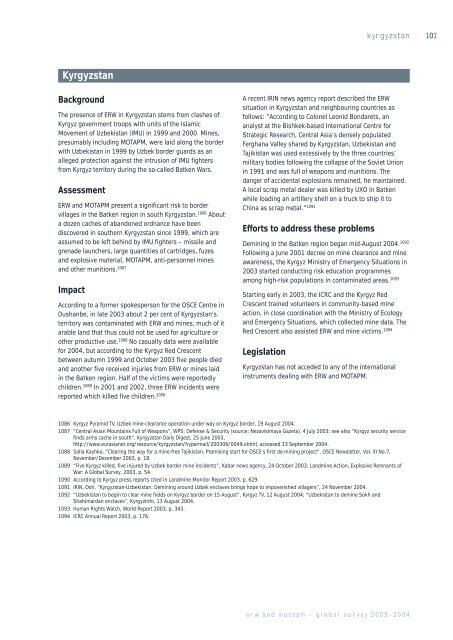Country & Territory Reports - Landmine Action
Country & Territory Reports - Landmine Action
Country & Territory Reports - Landmine Action
Create successful ePaper yourself
Turn your PDF publications into a flip-book with our unique Google optimized e-Paper software.
Kyrgyzstan<br />
Background<br />
The presence of ERW in Kyrgyzstan stems from clashes of<br />
Kyrgyz government troops with units of the Islamic<br />
Movement of Uzbekistan (IMU) in 1999 and 2000. Mines,<br />
presumably including MOTAPM, were laid along the border<br />
with Uzbekistan in 1999 by Uzbek border guards as an<br />
alleged protection against the intrusion of IMU fighters<br />
from Kyrgyz territory during the so-called Batken Wars.<br />
Assessment<br />
ERW and MOTAPM present a significant risk to border<br />
villages in the Batken region in south Kyrgyzstan. 1086 About<br />
a dozen caches of abandoned ordnance have been<br />
discovered in southern Kyrgyzstan since 1999, which are<br />
assumed to be left behind by IMU fighters – missile and<br />
grenade launchers, large quantities of cartridges, fuzes<br />
and explosive material, MOTAPM, anti-personnel mines<br />
and other munitions. 1087<br />
Impact<br />
According to a former spokesperson for the OSCE Centre in<br />
Dushanbe, in late 2003 about 2 per cent of Kyrgyzstan’s<br />
territory was contaminated with ERW and mines, much of it<br />
arable land that thus could not be used for agriculture or<br />
other productive use. 1088 No casualty data were available<br />
for 2004, but according to the Kyrgyz Red Crescent<br />
between autumn 1999 and October 2003 five people died<br />
and another five received injuries from ERW or mines laid<br />
in the Batken region. Half of the victims were reportedly<br />
children. 1089 In 2001 and 2002, three ERW incidents were<br />
reported which killed five children. 1090<br />
A recent IRIN news agency report described the ERW<br />
situation in Kyrgyzstan and neighbouring countries as<br />
follows: “According to Colonel Leonid Bondarets, an<br />
analyst at the Bishkek-based International Centre for<br />
Strategic Research, Central Asia’s densely populated<br />
Ferghana Valley shared by Kyrgyzstan, Uzbekistan and<br />
Tajikistan was used excessively by the three countries’<br />
military bodies following the collapse of the Soviet Union<br />
in 1991 and was full of weapons and munitions. The<br />
danger of accidental explosions remained, he maintained.<br />
A local scrap metal dealer was killed by UXO in Batken<br />
while loading an artillery shell on a truck to ship it to<br />
China as scrap metal.” 1091<br />
Efforts to address these problems<br />
Demining in the Batken region began mid-August 2004. 1092<br />
Following a June 2001 decree on mine clearance and mine<br />
awareness, the Kyrgyz Ministry of Emergency Situations in<br />
2003 started conducting risk education programmes<br />
among high-risk populations in contaminated areas. 1093<br />
Starting early in 2003, the ICRC and the Kyrgyz Red<br />
Crescent trained volunteers in community-based mine<br />
action, in close coordination with the Ministry of Ecology<br />
and Emergency Situations, which collected mine data. The<br />
Red Crescent also assisted ERW and mine victims. 1094<br />
Legislation<br />
Kyrgyzstan has not acceded to any of the international<br />
instruments dealing with ERW and MOTAPM.<br />
kyrgyzstan 101<br />
1086 Kyrgyz Pyramid TV, Uzbek mine-clearance operation under way on Kyrgyz border, 19 August 2004.<br />
1087 “Central Asian Mountains Full of Weapons”, WPS: Defense & Security (source: Nezavisimaya Gazeta), 4 July 2003; see also “Kyrgyz security service<br />
finds arms cache in south”, Kyrgyzstan Daily Digest, 25 June 2003,<br />
http://www.eurasianet.org/resource/kyrgyzstan/hypermail/200306/0049.shtml, accessed 13 September 2004.<br />
1088 Salla Kayhko, “Clearing the way for a mine-free Tajikistan, Promising start for OSCE’s first de-mining project”, OSCE Newsletter, Vol. XI No.7,<br />
November/December 2003, p. 18.<br />
1089 “Five Kyrgyz killed, five injured by Uzbek border mine incidents”, Kabar news agency, 24 October 2003; <strong>Landmine</strong> <strong>Action</strong>, Explosive Remnants of<br />
War: A Global Survey, 2003, p. 54.<br />
1090 According to Kyrgyz press reports cited in <strong>Landmine</strong> Monitor Report 2003, p. 629.<br />
1091 IRIN, Osh, “Kyrgyzstan-Uzbekistan: Demining around Uzbek enclaves brings hope to impoverished villagers”, 24 November 2004.<br />
1092 “Uzbekistan to begin to clear mine fields on Kyrgyz border on 15 August”, Kyrgyz TV, 12 August 2004; “Uzbekistan to demine Sokh and<br />
Shahimardan enclaves”, Kyrgyzinfo, 13 August 2004.<br />
1093 Human Rights Watch, World Report 2003, p. 343.<br />
1094 ICRC Annual Report 2003, p. 176.<br />
erw and motapm – global survey 2003–2004


